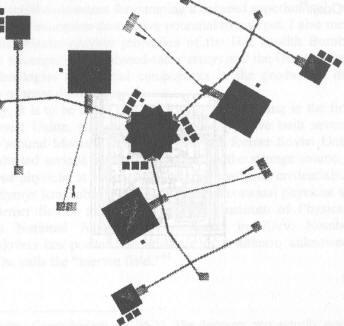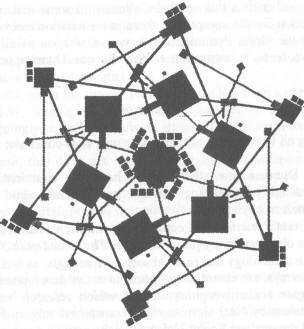Grid of the Gods (55 page)
Authors: Joseph P. Farrell,Scott D. de Hart

In Korzyrev’s thinking, however, torsion is not an abstract, static thing, but rather a constantly changing, dynamic thing,
for if the basic idea of torsion is that it is related to a rotating system, then it will be apparent that the universe is composed of rotating systems within other rotating systems, producing a continuously changing system with a changing
flow
of time… time
itself
takes on dynamic properties.
Such complex, interlocked systems of rotation may be thought of as “knots” of space-time that are so intensely concentrated that they form the objects observed in the physical universe. As such,
all systems are in fact “space-time machines,” and since they “contain” space-time they are not ultimately “constrained” by it, but rather, interact constantly, and in some cases, instantaneously, with it.
26
The Vedic cosmology says essentially the same thing, and consequently, if one presses the speculation a great deal, one may say that it is saying that torsion forms the ultimate basis for the declined alchemical analogical magic so prevalent in the legacy civilizations.
With these thoughts in mind, we now take a closer look at the two large pyramids of Giza, for there we find the idea of torsion, of a
twist
, present in the structures themselves. It was the renowned Italian metrologist Stecchini who observed that the Great Pyramid’s four sides were all of slightly different lengths and angles from each other, producing a slight twist to the northwest corner of the structure.
27
Many who have studied the Great Pyramid have commented on this feature, calling it a “slight imperfection” and other such phrases.
But is it?
Given all the other extraordinary perfection in the structure, we must ask whether this is a likely explanation, or if this twist in the structure is there
intentionally
?
There are two things arguing for its intentionality. The first is, as we have seen, the deeply esoteric connection between Egyptian cosmology and the more ancient topological metaphor contained within it, a metaphor connecting it to other ancient cosmologies. Within that metaphor, as we saw, the pyramid itself is seen as an analogue to the whole cosmic process of differentiation. If, as we also suggested, the Great Pyramid could possibly stem from a time of construction somewhere in High Antiquity, such scientific concepts might have been very well-known and deliberately built-in to the structure.
But there is a much stronger argument that suggests this twist was fully intentional, and that is the fact that the
second
large pyramid of Giza
also
has such a twist. The great archaeologist and surveyor of Giza, Sir William Flinders Petrie, whose
The Pyramids and Temples of Gizeh
form the “bible” for any serious Giza research, detailed a number of curious features about the
Second
Pyramid. Observing that the top of the Second Pyramid still has some of its casing stones on it, and taking theodolite readings on the angles, Petrie stated that “From this it is seen that the builders skewed round the planes of the casing as they went upward; the twist being +1’40’’ on the mean of the sides; so that it is absolutely — 3’50’’ from true orientation at the upper part.”
28
Additionally, unlike the Great Pyramid, whose alignment to the four cardinal compass points are almost perfect, the Second Pyramid is twisted even further off alignment to the true compass points; in short, the structure itself is twisted, and in addition, twisted off center relative to the compass points.
29
The significance of the two large pyramids being twisted is not, in our opinion, accidental, for there is a
third
consideration that points, once again, very deliberately to the idea that the compound was designed as an analogue of torsion. In
The Giza Death Star Deployed
I pointed out that when one runs an axis of rotation through the apex
of the Great Pyramid, and then rotates the compound through 120 and 240 degrees, two familiar forms result.

Middleton-Jones’ and Wilkie’s Overhead Rotation of Giza through 120 Degrees
30
Note that the slight offset of the three large pyramids (remembering that the Great Pyramid is the center of rotation in the above diagram) yields a three-armed swastika, a common symbol of rotation in the Vedic tradition, and if the compound were rotated through 90 degree increments, the resemblance would be even more palpable.
Rotation through 120 and then 240 degrees yields an even more striking symbol, and clearly indicates that the Giza compound was deliberately designed to be
rotated
, if not in reality, then at least conceptually:

Middleton-Jones’ and Wilkie’s Rotation of Giza Through 240 Degrees
31
So what do we have? We have at least
three
levels of rotation taking place at Giza:
1) Each of the two large pyramids is
twisted
from bottom to top, with the Great Pyramid being oriented slightly off center and toward the northwest corner;
2) In addition, both large pyramids deviate from true alignment to the four compass points, a divergence particularly true in the case of the Second Pyramid; that is, each is
twisted with respect to the Earth itself
;
3) Finally, the whole compound is also designed to rotate.
In other words, we have rotation within rotation within rotation, all on the surface of the Earth, which is rotating on its axis, revolving around the Sun, which is revolving
around the Galactic center.
32
To put it succinctly,
the Giza Compound is an analogy of the concept of dynamic torsion.
If, therefore, as engineer Christopher Dunn has argued so persuasively in
The Giza Powerplant
, that the Great Pyramid was a
machine
for the production of power, or as I have argued in the
Giza Death Star Trilogy
that it might actually have been designed or utilized as a weapon of some sort, then this fact, plus the
three chronological levels of construction
evident at Giza, and its overall design, indicate that the entire compound may have been designed as some sort of machine, perhaps even one that
modified
the original function of the Great Pyramid, the first structure present at the compound on Alford’s alternative scheme of dating. And if the Grid is laid out with respect to Giza, then the
machine
of which Giza is the center, is truly massive.
The only questions that remain are, what was this vast machine designed to do, and how did it do it?
This is where the “answers” become highly speculative, and very technical…
Notes
1
John Michell,
The New View Over Atlantis
, p. 149.
2
John Michell
, The New View Over Atlantis
, p. 160.
3
Michell also notes that there is a tradition that the casing stones of the Great Pyramid were “said to have been engraved with letters and symbols expressing the entire knowledge of antiquity.” Ibid., p. 137.
4
Ibid., p. 162.
5
Ibid., pp. 156-157.
6
Michell,
The New View Over Atlantis
, p. 137.
7
See my
The Giza Death Star
(Adventures Unlimited Press, 2001), pp. 161-179.
8
Ibid., p. 174.
9
Ibid., pp. 174-175.
10
Ibid., p. 176.
11
Farrell,
The Giza Death Star
, p. 176.
12
Ibid.
13
Ibid.
14
Ibid., pp. 207-209, 217-221, see also
The Giza Death Star Deployed
, ch. 9.
15
Farrell,
The Giza Death Star Deployed
, p. 26. For our purposes here, I will review the dating and arguments of Alan Alford presented in that book. For a fuller discussion of the chronological issues there presented, see pp. 25-38.
16
Alan Alford,
The Phoenix Solution
:
Secrets of a Lost Civilization
(London, New English Library [Hodder and Stoughton], 1998), p. 6, cited in my
The Giza Death Star Deployed
, p. 27.
17
Farrell,
The Giza Death Star Deployed
, pp. 29-30.
18
Farrell,
The Giza Death Star Deployed
, pp. 31-32.
19
Alan Alford,
The Phoenix Solution
:
Secrets of a Lost Civilization
(London, New English Library [Hodder and Stoughton], 1998), p. 6, cited in my
The Giza Death Star Deployed
, p. 27.
20
My own intuition, as of this writing, is to ascribe great antiquity to Puma Punkhu at least, and possibly to the Great Pyramid as well, and to view the megaliths of Nabta Playa and Europe as the constructions of an elite undertaken in the aftermath of a catastrophe. There are, of course, problems occasioned by that view.
21
Farrell,
The Giza Death Star Deployed
, pp. 31-32.
22
Thomas G. Brophy, Ph.D.,
The Origin Map
, p. 90.
23
Thomas G. Brophy, Ph.D.,
The Origin Map
, p. 90, emphasis added.
24
Thomas G. Brophy, Ph.D.
, The Origin Map
, p. 91, emphasis Brophy’s.
25
Joseph P. Farrell,
The Philosophers’ Stone: Alchemy and the Secret Research for Exotic Matter
(Feral House, 2009), p. 156.
26
Ibid., p. 158, emphasis added.
27
Michell,
The New View Over Atlantis
, p. 147.
28
W. M. Flinders Petrie,
The Pyramids and Temples of Gizeh
(Elibron Classics, 2007), p. 97.
29
Ibid., p. 99.
30
Howard Middleton-Jones and James Michael Wilkie,
Giza-Genesis: the Best Kept Secrets
(Tempte, Arizona: Dandelion Books, 2001), p. 211.
31
Middleton-Jones and Wilkie
, Giza-Genesis: The Best Kept Secrets
, p. 213. For further commentary on these two figures, see my
The Giza Death Star Deployed
, pp. 132-134, 244-250.
32
For the presence of these three levels of celestial rotation at Giza, see again Thomas G. Brophy, Ph.D.,
The Origin Map
, p. 99.
P
ART
F
IVE
:
T
HE
P
HYSICS OF THE
“P
YRAMID
P
EOPLES
”
"From the relics of the Stone-Age science practised by the adepts of the ancient world it appears: first, that they recognized the existence of natural forces of whose potential we are now ignorant, and learnt to manipulate them; second, that they gained thereby certain insights into fundamental questions of philosophy, the nature of the universe and
